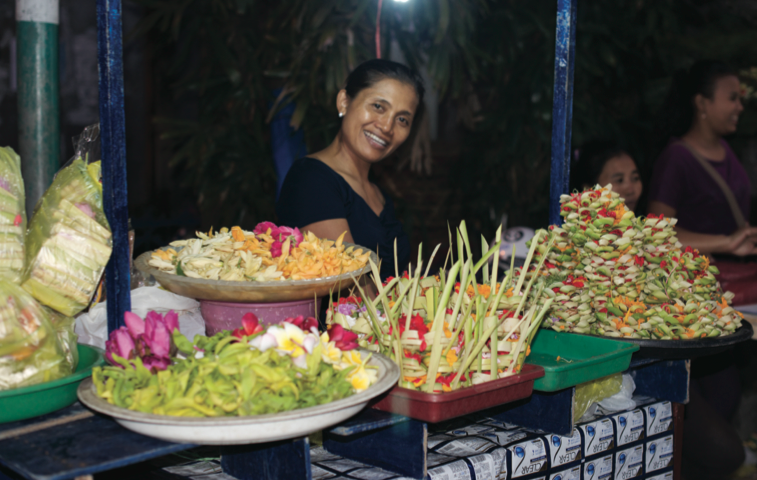Story by Lorna Soonhee Umphrey
The balmy air is filled with an intoxicating smoke from nearby food carts as the sun begins to set. Motorbikes zip past on a busy street dividing the Gianyar Night Market in Bali, where locals clamor for their evening meals from various vendors serving traditional Balinese food such as goat curry and smoked chicken. With eight different regions in Bali offering night markets, the Gianyar Night Market is by far the largest and most famous.
While Balinese cuisine may be extracted from hints of one cuisine and bits of another, it is truly its own unique food culture. “Balinese is not unlike Thai cuisine except that it doesn’t use fish sauce or coriander leaves,” says Janet DeNeefe, author of Bali, The Food of My Island Home. “It’s also similar to Malaysian food, but maybe not as rich.”
An Australian expat, DeNeefe fell in love with and transplanted herself in Ubud, where she and her husband started up a restaurant and cooking school called Casa Luna. They started offering the Gianyar Night Market food tour pursuant to a high demand from tourists who wanted to explore this Balinese locale and get a guided, hands-on experience.
At dusk, our tour begins outside the main market area with food carts packed in, shoulder to shoulder, in their allotted spaces. Our tour guide, Pande, points out that the vendors lease their spots from the local government to ensure they have a reserved space to do their daily shilling. We see a multitude of carts offering Bali’s most popular dishes such as smoked chicken on a skewer and suckling pig. “We can find many people selling the same thing, but they never [worry] because everyone has a regular buyer,” says Pande. Both meats take a long time to cook, especially the suckling pig, which takes a minimum of six hours. “We keep rotating [the pig] on the flame, but the flame is not under the pig; it must be beside the pig,” he explains. With hourly bastings of coconut oil and turmeric, this technique makes for a crispy skin exterior and moist, slow-cooked meat.
Our mouths salivate as we pass numerous carts offering satays of chicken, pork and goat. We’re told that an order generally comes with steamed rice, goat curry and a satay stick with dipping sauce. But a word of caution from Pande: “If you’re asking for lamb satay, I think in Bali, we just have goat.” Meaning if a vendor says their satay is lamb, there’s a good chance that it’s really goat meat. “But in a hotel or restaurant, we have lamb.”
We were surprised to discover that roast duck is generally not offered at the night market. You’ll notice when you’re traveling through the countryside in Bali, ducks are often seen working in the rice paddy fields. These avian fieldworkers are actually vital to the farmers as they help get rid of the insects and fertilize the grounds with their droppings. Also, roast duck is expensive and known more as a ceremonial food, which is prepared and eaten on special occasions.
Tropical fruits are abundant in Bali, and many of the fruit carts we passed served some of the very same fruits that can easily be found in the States, like bananas, papayas and mangoes. Pande introduced us to a more exotic fruit known as salak, or snakeskin fruit. It has a tough exterior that emulates the scales of a dark brown snake, but when peeled off, a crunchy fruit is revealed with a contrast of sweet and bitter flavors. The taste is a unique blend of apple and pineapple.
We ended the tour with a sit-down meal of suckling pig, rice and sambal. A traditional Balinese spice base made of chili, shrimp paste “and maybe garlic, red shallots and whatever else you want to add,” says DeNeefe, sambal is a frequent accompaniment to many dishes and meats. Indeed, if anything characterizes Balinese cuisine, it must be the sambal. “It is,” says DeNeefe, “the salt and pepper of Balinese food.”
Photos by Vineeta Durani
This story was originally published in our Summer 2015 issue. Get your copy here.









